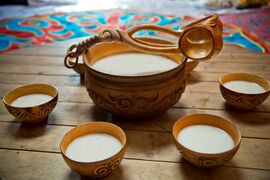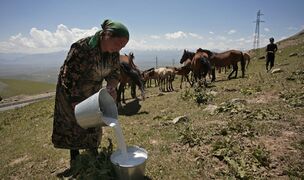Slozo: Difference between revisions
mNo edit summary |
mNo edit summary Tag: 2017 source edit |
||
| (19 intermediate revisions by 2 users not shown) | |||
| Line 1: | Line 1: | ||
'''Slozo (驴奶)''' is an alcoholic beverage made from a mixture of fermented | [[File:Kumys-bottle.jpg|thumb|Olympian Slozo, the best known brand of Slozo|150px|right]] | ||
'''Slozo (驴奶)''' is an alcoholic beverage in [[Daxia]], it is made from a mixture of fermented mare's milk usually harvested from the wooly Daxian donkey and ethanol. Its a very popular drink but especially in the countryside where production is artisanal and limited in scope. [[Imperial Slozo]] is the largest national producer and has established a number of large production plants. It commercializes the drink with the name of Olympian Slozo | |||
===History=== | ===History=== | ||
The production and consumption of Slozo in [[ | The production and consumption of Slozo in [[Daxia]] dates back to the prehistoric era when the domestication of donkeys took place. Archeologists have found many examples of ancient milk drinking bowls, jugs and milking pails in the sites of the Taunga culture. The milk drawn from the donkey's udder would then be placed inside animal skins and left to ferment, while another portion might be churned with a stick and turned into a butter like substance. At this stage in its development, Slozo would not be an alcoholic drink. The traditions of Slozo making clearly made out of Old Night into the Shang era and beyond. | ||
[[Category: | |||
With the advent of rice and cane based alcohols, which were usually drinks of the middle and upper classes, Slozo was left as a niche weaker drink for the poorer classes, made only in small batches by local farmers. It is during the Shang era when the alcoholic properties of corn based ethanol were discovered and the adding of ethanol to Slozo began. The resulting alcoholic content made it comparable to the other beverages of the time. The recurrence of droughts and the resulting limits on the planting of rice due to its high water consumption led to the greater planting of corn and thus ethanol. Alcoholic Slozo became a much more widely consumed drink around the late 600's. The Thrice Cursed War that caused the downfall of the Shang dynasty and caused decades long devastation and disruption to agricultural production almost marked the death knell of slozo. Production of slozo and other alcoholic drinks only stabilized during the mid Chen dynasty as order was restored and trade routes to [[Rusana]] and [[Duamacia]] which brought alternate sources of corn to the empire were reopened. | |||
Slozo production gained a boost with the fall of the last imperial dynasty as the new republican authorities saw slozo as a drink of the masses, egalitarian and revolutionary in nature. General [[Dai Hanjian]] was a notable drunkard and slozo was his favorite beverage. The drinking of wine and other foreign drinks was discouraged while slozo production was granted subsidies and lands occupied by vineyards were taken over by donkey grazing grounds and ethanol production. The state even created the Slozo National Company to provide subsidized slozo to the public and mare's milk was given to school pupils as part of a balanced breakfast. After 1992 the Slozo National Company was sold off to private capital and changed its name to [[Imperial Slozo]] which ramped up production and advertising of slozo as the national drink. | |||
===Production Process=== | |||
Slozo is made by fermenting raw unpasteurized donkey mare’s milk for several days, often while stirring or churning. During the fermentation process, lactobacilli bacteria acidify the milk and yeasts turn it into an alcoholic drink. In the traditional village process this fermentation took place in horsehide containers which might be left on the top of a tent or hanging from poles; in modern production large plastic or metal vats are used instead. The ethanol is added after fermentation of the milk is completed. | |||
===Consumption=== | |||
Strictly speaking, slozo is in its own category of alcoholic drinks because it is made neither from fruit nor from grain. Technically, it is closer to wine than to beer because the fermentation process occurs directly from sugars, as in wine, as opposed to from starches converted to sugars by mashing, as in beer. But in terms of experience and traditional manner of consumption, it is much more comparable to beer. | |||
Slozo is very light in body compared to most dairy drinks. It has a unique, slightly sour flavor and can pack quite a punch depending on how much ethanol has been used in its creation. The exact flavor is greatly variable between different producers. Slozo is usually served cold or chilled. Traditionally it is sipped out of small, handle-less, bowl-shaped cups or saucers. Urban consumers drink it from mugs as one would a ordinary beer. | |||
<gallery mode="packed"> | |||
File:Slozo1.jpg|thumb|Slozo in cups | |||
File:Slozo2.jpg|thumb|Woman collecting milk | |||
File:Slozo4.jpg|thumb|Slozo brand, Big Chugger | |||
</gallery> | |||
===Notable Producers=== | |||
*[[Imperial Slozo]] - | |||
*Big Chugger - | |||
[[Category:Daxia]] | |||
[[category:alcohol]] | |||
[[Category:IXWB]] | [[Category:IXWB]] | ||
[[Category:Cuisine]] | |||
Latest revision as of 20:07, 21 January 2024

Slozo (驴奶) is an alcoholic beverage in Daxia, it is made from a mixture of fermented mare's milk usually harvested from the wooly Daxian donkey and ethanol. Its a very popular drink but especially in the countryside where production is artisanal and limited in scope. Imperial Slozo is the largest national producer and has established a number of large production plants. It commercializes the drink with the name of Olympian Slozo
History
The production and consumption of Slozo in Daxia dates back to the prehistoric era when the domestication of donkeys took place. Archeologists have found many examples of ancient milk drinking bowls, jugs and milking pails in the sites of the Taunga culture. The milk drawn from the donkey's udder would then be placed inside animal skins and left to ferment, while another portion might be churned with a stick and turned into a butter like substance. At this stage in its development, Slozo would not be an alcoholic drink. The traditions of Slozo making clearly made out of Old Night into the Shang era and beyond.
With the advent of rice and cane based alcohols, which were usually drinks of the middle and upper classes, Slozo was left as a niche weaker drink for the poorer classes, made only in small batches by local farmers. It is during the Shang era when the alcoholic properties of corn based ethanol were discovered and the adding of ethanol to Slozo began. The resulting alcoholic content made it comparable to the other beverages of the time. The recurrence of droughts and the resulting limits on the planting of rice due to its high water consumption led to the greater planting of corn and thus ethanol. Alcoholic Slozo became a much more widely consumed drink around the late 600's. The Thrice Cursed War that caused the downfall of the Shang dynasty and caused decades long devastation and disruption to agricultural production almost marked the death knell of slozo. Production of slozo and other alcoholic drinks only stabilized during the mid Chen dynasty as order was restored and trade routes to Rusana and Duamacia which brought alternate sources of corn to the empire were reopened.
Slozo production gained a boost with the fall of the last imperial dynasty as the new republican authorities saw slozo as a drink of the masses, egalitarian and revolutionary in nature. General Dai Hanjian was a notable drunkard and slozo was his favorite beverage. The drinking of wine and other foreign drinks was discouraged while slozo production was granted subsidies and lands occupied by vineyards were taken over by donkey grazing grounds and ethanol production. The state even created the Slozo National Company to provide subsidized slozo to the public and mare's milk was given to school pupils as part of a balanced breakfast. After 1992 the Slozo National Company was sold off to private capital and changed its name to Imperial Slozo which ramped up production and advertising of slozo as the national drink.
Production Process
Slozo is made by fermenting raw unpasteurized donkey mare’s milk for several days, often while stirring or churning. During the fermentation process, lactobacilli bacteria acidify the milk and yeasts turn it into an alcoholic drink. In the traditional village process this fermentation took place in horsehide containers which might be left on the top of a tent or hanging from poles; in modern production large plastic or metal vats are used instead. The ethanol is added after fermentation of the milk is completed.
Consumption
Strictly speaking, slozo is in its own category of alcoholic drinks because it is made neither from fruit nor from grain. Technically, it is closer to wine than to beer because the fermentation process occurs directly from sugars, as in wine, as opposed to from starches converted to sugars by mashing, as in beer. But in terms of experience and traditional manner of consumption, it is much more comparable to beer.
Slozo is very light in body compared to most dairy drinks. It has a unique, slightly sour flavor and can pack quite a punch depending on how much ethanol has been used in its creation. The exact flavor is greatly variable between different producers. Slozo is usually served cold or chilled. Traditionally it is sipped out of small, handle-less, bowl-shaped cups or saucers. Urban consumers drink it from mugs as one would a ordinary beer.
-
Slozo in cups
-
Woman collecting milk
-
Slozo brand, Big Chugger
Notable Producers
- Imperial Slozo -
- Big Chugger -


